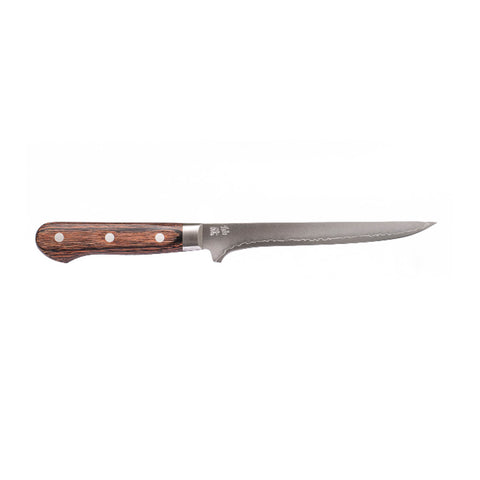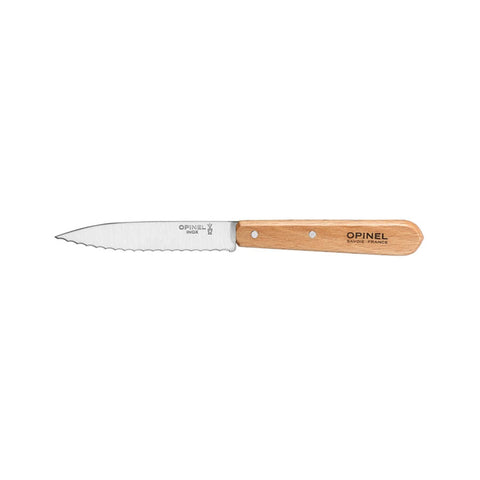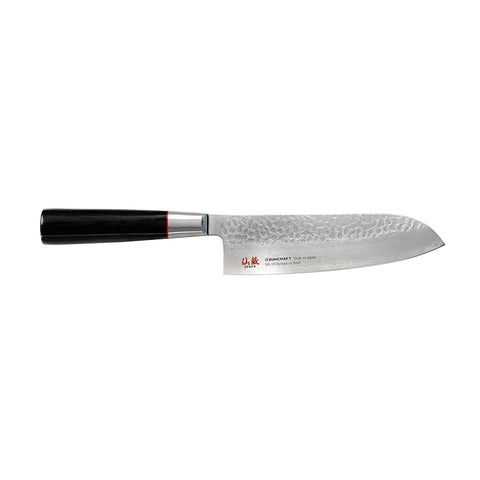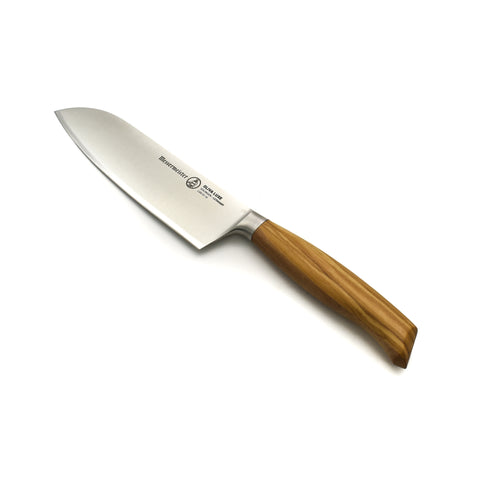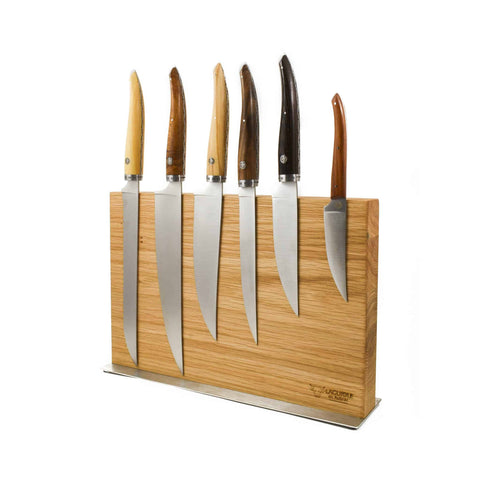Everything You Need To Know About The Best Kitchen Knives
by The Sous Chef Team

In the kitchen, having the best knives is crucial for good results. A good knife feels almost like the extension of your own hand, and should allow you to chop, peel, slice and dice incredibly easily.
There are some important factors that make a good knife - but ultimately it's a personal choice. So that's why we've turned to the expert Sous Chef team, to gather their recommendations and favourite kitchen knives.
Read through the selection below, as well as some simple guidance on how to choose the best kitchen knife.
Sous Chef knife experts
In this guide, you’ll hear from Sous Chef buyer Kristin Lohse, who has many years of kitchen knife experience - and is a true expert in sharpening and caring for knives. And Sous Chef food editor Holly Thomson, who has been trained in knife skills by expert chefs and cookery teachers.
Plus Sous Chef founder Nicola Lando will share her insight and expertise. Nicola has worked in a Michelin kitchen, and knows first-hand which are the knives top chefs love. She also has over a decade of experience talking to knife makers, small producers and artisan kitchen knife brands, from around the world.
Plus you'll hear from the Sous Chef Team about our favourite knives!
In this expert blog, we’ll discuss:
- How to choose which kitchen knife to buy and what to look for
- What is the difference between expensive and cheap knives
- Key features of the best kitchen knives
- What are the best kitchen knives for different tasks in the kitchen
- What type of knife is the safest to use in the kitchen
- What kitchen knives do chefs recommend
- What are the best kitchen knives set for me?
How to choose a kitchen knife and what to look for? 5 questions before you buy
1. What is your kitchen knife used for?
Firstly, you have to answer this simple question. Different tasks require different kitchen knives. And if you’ve been accidentally using the wrong knife for the wrong task, you’ll be amazed by the difference it makes. For example:
- A Chef's knife, with its broad and versatile blade, is ideal for a variety of tasks. Because of its size, it’s mainly used for preparing larger ingredients and cuts of meat.
- A Paring knife on the other hand is smaller and more agile. And is designed for peeling or cutting smaller ingredients, and other precise work.
- Meanwhile, a Serrated knife is for cutting through tougher ingredients. Bread knives are of course serrated. Smaller serrated knives are also great for slicing tomatoes without crushing them.
2. What is your knife made from?
The material of your knife’s blade is crucial. There are several different options:
- Stainless steel is popular due to its rust resistance and ease of maintenance.
- High-carbon steel blades are sharper and hold an edge longer but require more care to prevent rust.
- Ceramic blades are incredibly sharp and lightweight but can be brittle and challenging to sharpen at home.
- You can also find plastic blades - often used as ‘salad knives’, and called Lettuce Knives. Great for shredding an Iceberg lettuce!
3. Will the handle be comfortable?
Your new knife should feel balanced and comfortable in your hand, as this reduces finger fatigue during extended use. Handles can be made from a variety of materials, including wood, plastic, and metal. This can be hard to test when buying online, of course. So it’s a good idea to check the reviews and fellow customer comments.
BUT there are a few simple things to indicate whether a knife will be comfortable, before you buy online:
- Wooden handles offer a good grip and can be lighter than metal handles. A good choice for smaller hands, or if you don’t have huge arm strength. Look for a shape that will fit neatly into your hand.
- Metal handles are sturdy and often heavier than wooden versions. So you might find these most comfortable if you have a strong wrist, or larger hands. The weight also means they will be more comfortable for bigger chopping jobs - so a good choice if you often prepare large root vegetables, for example!
- Regardless of material, consider your hand size and whether you will be comfortable using a larger handle or a smaller one.
4. How is the knife made?
The construction of the knife affects its balance and strength. Forged knives (such as the Senzo 33), made from a single piece of heated and hammered metal, offer superior balance and durability. Stamped knives, cut from a large sheet of metal, are usually lighter and less expensive but might not have the same balance or durability as forged knives.

Top Tip: You might hear people talk about ‘full tang’ blades - pictured above. This means the blade extends right the way through the handle. This means there is no ‘join’ between the handle and the cutting edge. Full tang knives are most likely to be durable and last you well in the kitchen.
5. How much does a good knife cost?
The price of a knife can be indicative of its quality, but more expensive doesn't always mean better. Set a budget that works for you, but also consider the knife's construction, material, and expected lifespan. Often, investing in a slightly more expensive knife can offer better value over time, due to its longevity and performance.
The cost of a knife can also be higher if you’re interested in bespoke knives. Or, for instance, knives that have been custom made by a single artisan. These are very special kitchen knives you’ll cherish. But part of the price covers specialist workmanship and skills. As well as the knife itself.
It’s very possible to find lower price knives that still perform very well in the kitchen, and will last a long time.

What is the difference between expensive and cheap knives?
The distinction between expensive and cheap knives lies in several key factors including:
- Edge retention
- Construction process
Durability
Understanding these differences can help determine whether an expensive knife is a worthwhile investment for your kitchen or if a more affordable option suits your needs.
Edge retention
Your kitchen knife material quality is a primary factor when choosing which one to buy. And the blade material will dictate whether it stays sharp. Expensive kitchen knives are often crafted from high-grade steel, such as high-carbon stainless steel or Damascus steel. These types of steel are known for their edge retention and resistance to corrosion.
In contrast, cheaper knives might be made from lower quality stainless steel, which is less durable and prone to dulling more quickly.
However, be aware that harder steel, while offering better edge retention, can be more difficult to sharpen.
Construction process
The construction process of your kitchen knife plays a significant role. Expensive knives are typically forged, a method involving heating and hammering the metal into shape. This process results in a denser and stronger knife, offering better balance and a longer lifespan.
Cheap knives are often stamped, cut out from a large sheet of metal, leading to a lighter and sometimes less balanced tool.
Durability and longevity
Durability and performance are where expensive knives truly stand out. With proper care, a high-quality knife can last a lifetime, maintaining its sharpness through countless uses. The precision and ease of cutting with a well-made knife can make food preparation more efficient and enjoyable.
On the other hand, cheaper knives might require more frequent sharpening and may not provide the same level of performance, potentially leading to more effort and less precise cuts.
What makes an expensive knife better?

Aside from the factors already mentioned, expensive knives often come with ergonomic handles designed for comfort and safety, reducing hand fatigue during prolonged use. The attention to detail in the design and finish of these knives can also enhance the overall cooking experience.
Buying from small artisan makers can also be more expensive. But these knives are supporting experts in the trade, and keeping alive ancient knife-making skills.
Are cheap kitchen knives good?
It depends on your cooking habits and expectations. For occasional cooks or those on a tight budget, a well-made inexpensive knife can be a good choice. Especially if it's maintained properly.
Read more: How to care for your kitchen knife
However, for those who are passionate about cooking either as a hobby - or a profession - investing in a more expensive knife is certainly worthwhile. And it can even be cheaper in the long-term, as you won’t need to replace it so often.
Do I need an expensive chef’s knife?
A chef’s knife is one of the core knife shapes in the kitchen - so if you are looking to invest in just one great knife, it could be that the chef’s knife is the one to choose.
Professional chefs or cooking enthusiasts will benefit from the investment due to the knife's longevity, balance, and precision.
A chef’s knife can be incredibly versatile. Use it to chop meat, vegetables and fish. To rock-chop herbs; score fish skin; cube tofu; or paste fresh garlic. So with hundreds of uses in the kitchen, it can be a sensible choice to invest in an expensive chef’s knife, rather than any other.
How much do kitchen knives cost?
The cost of kitchen knives really depends on your needs in the kitchen. As a benchmark, good quality kitchen knives start between £20-£50.
And as a rule, the more you spend, the more superior the materials and craftsmanship. And of course, once you start looking at custom or handmade knives, or bespoke blades with personalised handles - the cost can quickly rise.
Choosing the right knife comes down to balancing your cooking frequency, budget, and how much value you place on efficiency and ease of use.
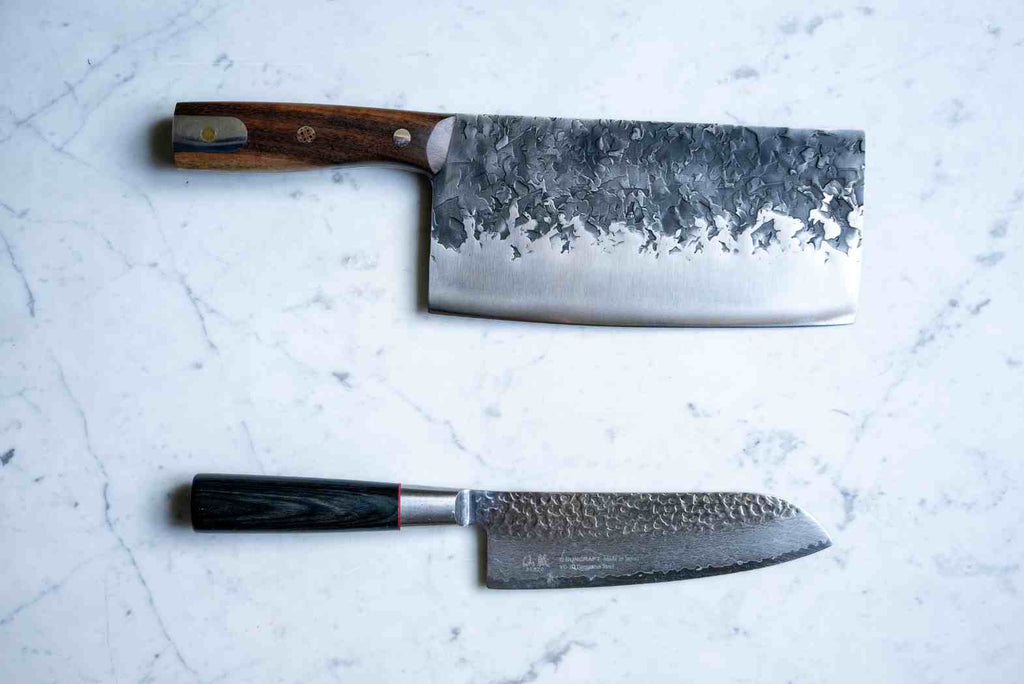
Key features of the best kitchen knives
There are several defining factors that indicate a knife’s quality. Here is a summary of the key factors that many good knives share:
Stainless steel blades. High-quality knives are often made from high-carbon stainless steel, which combines the best of both worlds: the rust resistance of stainless steel and the superior edge retention of high carbon steel. Examples include the Messermeister 'Custom Chef' Chef's Knife and Opinel Parallele Beech Handle Santoku Knife N.119.
Forged, or full-tang blades. Another important feature is the knife’s construction. Forged knives, crafted from a single piece of steel that is heated and shaped, offer a balance and heft that many chefs and cooking enthusiasts prefer. Great example is the Japanese AUS10 Chef's Knife 210mm.
A slim blade angle. A sharper angle on your knife’s blade, typically between 15 and 20 degrees on each side, provides a sharper edge. And this makes slicing easier and more accurate. We recommend Yasuo Black Bunka Knife.
Balanced handle and blade. The balance point should ideally be where the handle and blade meet. This significantly affects comfort and safety. Ergonomic handles that are well balanced with the blade prevent hand fatigue and enhance control during use. One great example is the Seki 3 Layer Gyuto Knife. Regardless of the specific materials, your knife should feel comfortable in the hand and make cutting feel less strenuous.

What are the best kitchen knives for different tasks in the kitchen?
In the kitchen, having the right knife for the task can make food preparation more efficient, safer, and enjoyable. Different types of kitchen knives are designed to handle various food items and cutting techniques, from slicing delicate fruits to carving dense meats.
Best kitchen knives for cutting vegetables
For vegetables, a chef's knife is incredibly versatile, suitable for chopping, dicing, and slicing a wide range of produce. A Nakiri knife is also suitable for vegetables.
Best kitchen knives for cutting meat
When it comes to cutting meat, the type of meat and the cut you're preparing influence the choice of knife. For slicing through thick cuts of meat at the table, a carving knife, with its long and narrow blade, is ideal.
For more intricate tasks like boning or trimming fat, a boning knife, we suggest using the Japanese AUS10 Boning Knife.
Kristin says: “It has a firm blade with a pointed tip to easily cut around the bones when deboning a chicken or other piece of meat.”
Best kitchen knives for cutting fruits
Fruit preparation often requires a knife that can handle both the delicate nature of the fruit and provide clean cuts.
A serrated utility knife is perfect for slicing through the soft skins of fruits without crushing the flesh, specifically Opinel Essentials Beech Handle Serrated Knife. Its serrated edge grips the surface, allowing for precise slices.
Kristin says “This knife is perfect for fruit that can be a bit slippery, like Kiwi, Mango and peaches. Senzo 33 Layer Peeling Knife is excellent for peeling and shaping round fruits."
What knife is best for cutting, chopping, and slicing
The Santoku knife, a Japanese-style all-purpose knife, is outstanding for cutting, chopping, and slicing a variety of foods.
Its design features a shorter blade with a slight curve, making it easy to handle. Yasuo Black Santoku Knife is known for its sharpness and balance, providing smooth cuts and versatility for handling meats, vegetables, and fruits alike.
Kristin says: “Not just beautiful, this knife has a lightweight handle that sits comfortably in your palm, and a strong damascus steel blade that hold it's edge very well for easy use every day.”
What knife is best for cutting raw chicken?
Cutting raw chicken requires a knife that can handle both the precision of slicing through meat and the durability to cut through joints.
A chef's knife or a Santoku knife can serve well for slicing breast meat or deboning thighs. However, for cutting through bones, a heavier duty option like a cleaver may be necessary for some tasks.
Kristin says “The Messermeister Chef’s Knife is a slightly heavier knife with a comfortable olive wood handle, works well if you like chopping in a rocking motion.”
What knife is the most useful in the kitchen?
The chef's knife stands out as the most versatile and widely used tool in kitchens around the world. Characterised by its broad, typically 8-inch long blade, it offers unmatched flexibility for a variety of tasks, from slicing fruits and vegetables to chopping herbs and cutting meat.
This knife's design allows for significant control and precision, making it a favourite among both professional chefs and home cooks. Opinel Parallele Beech Handle Chefs Knife N.118, for instance, is celebrated for its lightweight feel and sharp edge, making it easy to use for extended periods without hand fatigue. Similarly, Seki 3 Layer Gyuto Knife is lauded for its durability and balance, providing a reliable cutting tool that can handle the rigours of daily use.
The chef's knife's ability to support a multitude of cutting techniques, such as the rocking motion for mincing garlic or the straightforward chop for vegetables, underscores its utility.
It bridges the gap between specialised knives, offering a one-knife solution for most kitchen tasks. Its ergonomic design ensures comfort and safety, reducing the risk of accidents while speeding up meal prep.
What type of knife is the safest to use in the kitchen?
Safety in the kitchen is paramount, and when it comes to kitchen knives, certain types are designed with features that enhance safety without compromising on performance.
A well-maintained knife
A sharp and clean, is safer to use. Dull knives require more force to cut, increasing the risk of slipping and causing an injury. Therefore, using a knife sharpener regularly, can keep your knives in optimal condition, enhancing safety.
A knife with good grip
If your hand fits neatly and comfortably around the handle, you are more in control of the knife. Choose one that is the right size for your hand - ie not too large. And if you find it more comfortable, look for a handle with finger grooves. For added grip.
What kitchen knives do chefs recommend

What type of knives do chefs use?
Chefs navigate their busy kitchens with a curated selection of kitchen knives tailored to specific tasks. Many will have a knife set they keep on them at all times.
What knives are in a chef’s knife set?
- One essential is the chef's knife, a versatile all-rounder for slicing, dicing, and chopping. It's the daily workhorse, effortlessly tackling slicing, dicing, and chopping duties with precision.
- Filleting fish requires the precision of a flexible filleting knife,
- Delicate tasks like peeling and trimming find a perfect match in a paring knife.
- Cleavers, with their heft, excel at heavy-duty tasks like breaking down large cuts of meat or dense vegetables.
- Specialty knives like the Santoku bring a Japanese flair to the kitchen, excelling in precision and fine slicing.
- The serrated edge of a bread knife effortlessly tackles crusty loaves without squashing the soft interiors.
- Smaller serrated knives are great for fruit and vegetables with tougher skin, such as tomatoes.
What knife size do most chefs use?
Most chefs swear by an 8-inch blade. This versatile size strikes a balance, allowing for nimble movements when precision is key, while still offering enough length for more substantial cutting tasks.
The 8-inch knife can seamlessly transition from delicate herb work to tackling larger cuts of meat. Its manageable size caters to a range of culinary needs without overwhelming the chef.
While personal preferences may vary, this middle-ground size remains a popular choice among culinary professionals for its adaptability and ease of use.
So, if you're contemplating the ideal knife size for your kitchen, consider the pragmatic 8-inch blade.

What are the best kitchen knives set for me?
Kristin says "The best kitchen knife sets depend on your specific needs. For keen cooks, high-quality sets offer longevity and precision, our best suggestion is Laguiole en Aubrac Classic Knife Block of 6 Kitchen Knives, Juniper or Messermeister 8 Piece Knife Block Set. These sets usually feature a variety of knives for different tasks, ensuring you're well-equipped for any recipe.
Expect materials that hold an edge longer, requiring less sharpening. For casual kitchen use, another affordable option is Messermeister Avanta 10 Piece Knife Block Set or Opinel Parallele 5 Piece Knife Block Set. While they might need more attention to keep sharp, they still do the job well. It's all about the right fit for your cooking frequency and maintenance willingness."
What is a good set of kitchen knives?
The best kitchen knife sets on a budget
Finding the best kitchen knife set on a budget doesn't mean compromising on quality. Key is to look for sets that offer the essentials without the frills. A well-curated set should include a versatile chef's knife, a precise paring knife, and a useful serrated knife. These two can handle most kitchen tasks efficiently.
An entry level set including all the essentials. This block will stand you in good stead across nearly all kitchen tasks.
The best kitchen knife sets for a meat-lover
This block from Messermeister includes most of the essentials (although not a bread knife). However, it has 4 steak knives and a carving knife included. A really great choice for every meat lover! The Messermeister Avanta knife range design was inspired by one of the leading culinary schools in America, to create a knife range that was not only of the highest quality and performance, but that could withstand all the demands of a bustling cookery school.
The best artisan kitchen knife set
Laguiole en Aubrac brought the art of knife-making back to Espalion in the 20th century, creating the highest quality, artisanal stainless steel knives. The original Laguiole knife dates back to 1829, when a simple folding knife became the talk of not only the town, but the whole country, loved for its practicality and elegant, intricate design.
Fast forward to the 21st century and Laguiole en Aubrac are lovingly creating knives once again. All knives are individually hardened by hand; shaping and fitting are done by hand to the craftsman’s eye. Each knife is assembled from start to finish in one sequence and by a single craftsman.
A beautiful high-quality knife set. Includes all the essentials and a filleting knife for the person who eat a lot of fish.
Opinel’s Parallele 5-piece knife block set has a blade for every kitchen task. This knife set is ideal for chefs looking to expand their knife collection and would also make a great gift. With smooth beech wood handles, these knives are durable and versatile - perfect for everyday use. Each blade is made from high quality stainless steel which is resistant to wear and corrosion.
The Opinel Parallele knife trio is a fantastic knife set for any keen cook. Whether you’re looking to start your own knife collection or gifting a set to an aspiring chef, these knives are a great start for the essentials. Each blade has a smart beech wood handle and sharp stainless steel blade. The high quality steel is resistant to wear and corrosion so these knives will stand the test of time, even after frequent use.
How long does a kitchen knife set last?
The lifespan of a kitchen knife set depends on the material, use, and care. High-quality stainless steel or ceramic sets can last a lifetime with proper maintenance. Regular honing and occasional professional sharpening keep them in top condition.
For those who cook frequently, investing in a durable set pays off. These knives withstand daily use, maintaining sharpness and integrity. Care is simple: wash by hand, dry immediately, and store safely.
Less expensive sets might need more care or earlier replacement. However, even budget-friendly options can serve well for years with attention to upkeep.
Our top 10 kitchen knives
In no particular order
- Senzo 33 Layer Santoku Knife 165mm
Excellent quality Japanese Santoku knife. The hammered finish also helps to create air pockets when chopping to avoid food sticking too much to your blade - Japanese AUS10 Petty Knife 135mm
A great option for that in-between knife - between a paring and chef's knife. - Opinel Bread Knife With Beechwood Handle
Our best-selling bread knife. Amazing price point and perfect for sourdough loaves. - Nakiri Knife, 16cm
Entry level Nakiri knife with a classic oval japanese handle. Great if you're curious about the Nakiri knife, but not yet prepared to splurge - Messermeister Oliva Luxe Chef's Knife, 20cm
Slightly more heavyweight than your classic Japanese knives. This western style Chef's knife has a very comfortable olive wood handle, and has a perfectly sharp edge and great for your everyday tasks. - Seki 3 Layer Gyuto Knife, 20cm
All time favourite kitchen workhorse. Ultra sharp blade from Japanese steel that retains it's edge for a very long time. It has a fine pointed tip for those precision tasks. Beautiful ergonomic handle that is curved to fit your hand, and a beautiful brass bolster that creates a patina over time. - Laguiole en Aubrac Carving Set, Juniper
Our most favourite luxury carving set with gorgeous Juniper wood. Custom made in France. Treat yourself or a friend. - Katto Rosewood Handle Santoku Knife, 19cm
UK made with high quality Japanese AUS10 steel, with a black hammered pattern and hand carved rosewood handle. - Yasuo Black Bread Knife, 22cm
Level up your bread knife with this beautiful damascus steel blade and black and red handle in a classic Japanese octagonal shape. - Opinel Red Le Petit Chef 3 Piece Children's Knife Set
All time favourite set for the budding young chef in your life.
Where to buy the best kitchen knives
"Where to buy sharp kitchen knives?" you ask. Sous Chef is your go-to destination. We offer a carefully selected collection that meets all your chopping needs. From professional chefs to home cooking enthusiasts, our range caters to everyone. Our Japanese knives are a highlight, known for their sharpness and durability. They make slicing through vegetables and meats a breeze.
At Sous Chef, we believe a good knife can transform your cooking experience. That's why we invite you to explore our kitchen knives collection. Discover the perfect match for your kitchen today.
Sous Chef Team's Best Kitchen Knives
Choosing which kitchen knives you should get in your kitchen is the first step when considering the best kitchen knives. Here at Sous Chef, we carefully choose the best kitchen knives suitable for your everyday and occasional needs!
Chef's Knife
Chef’s knife is a kitchen workhorse, a versatile knife designed for chopping, slicing, and dicing. Ideal for a wide range of tasks, making it a must-have for any cook. Also, it is balanced and sharp, the chef's knife simplifies everyday food preparation.

Food Editor Holly says
“Among the kitchen knives that I have, this particular chef’s knife is my favourite. I use it every day! I really love the simplicity of it. The blade is the perfect shape for me, not overly curved, but still great for rock chopping.”
Paring Knife
A paring knife is a smaller knife with precise control, perfect for intricate tasks like peeling and trimming. Handy for jobs that require finesse, such as deveining shrimp or creating decorative cuts. This is indeed a go-to tool for delicate work, ensuring efficiency in the kitchen.

Marketing Executive Jannika says
“I find joy in crafting intricate cuts for the vegetables and fruits in my bento, and the Seki 3-Layer Paring Knife helps me achieve it! Plus, its steel is just one of the premium knife steels in the market, helps to prolong the sharpness.”
Bread Knife
Serrated edge for effortless slicing through crusty or soft bread without crushing. Bread knife ensures clean cuts in various baked goods, making it indispensable for bakers. Versatile enough to handle delicate pastries and tough crusts alike.

“This bread knife helps me easily cut through loaves and any other baked goods. I like making sourdoughs with lovely crusts, so it’s important to have a bread knife I love!”
Santoku Knife
Santoku knife is Japanese-inspired, with a shorter and wider blade than a chef's knife. Multipurpose, excelling in slicing, dicing, and chopping vegetables, meat, and fish. Its Granton edge reduces friction, allowing for smoother cuts and preventing food from sticking.

Purchasing Manager Ada says
“This is the knife that everyone should have in their kitchen. It seamlessly handles various tasks, from slicing meat to cheese. In fact, I often find myself using this with all of the chopping, slicing, and dicing tasks.”
To know more about kitchen knives, check out our Ultimate Guide to Kitchen Knives. Or if you’re curious on which kitchen knives you should buy, try reading our Buyer's Guide to Kitchen Knives. Happy cooking!

About the author
The Sous Chef team spends all day, every day hunting out the most exciting flavours, trends and recipes from across the world.
Every single team member tastes ingredients weekly, and cooks with the most up-to-date and classic cooking tools regularly. We're experts in ingredients and cookware from around the world.
We are constantly tasting new products, trying new recipes, and speaking to expert producers. For recipes and inspiration from the Sous Chef team, sign up for emails here.

